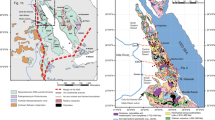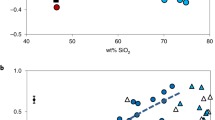Abstract
It is unclear how the earliest continental crust formed on an Earth that was probably originally surfaced with oceanic crust. Continental crust may have first formed in an ocean island-like setting, where upwelling mantle generates magmas that crystallize to form new crust. Of the oceanic plateaux, Iceland is closest in character to continental crust, because its crust is anomalously thick1 and contains a relatively high proportion of silica-rich (sialic) rocks2. Iceland has therefore been considered a suitable analogue for the generation of Earth’s earliest continental crust3. However, the geochemical signature of sialic rocks from Iceland4,5,6,7 is distinct from the typical 3.9- to 2.5-billion-year-old Archaean rocks discovered so far8. Here we report the discovery of an exceptionally well-preserved, 4.02-billion-year-old tonalitic gneiss rock unit within the Acasta Gneiss Complex in Canada. We use geochemical analyses to show that this rock unit is characterized by iron enrichment, negative Europium anomalies, unfractionated rare-earth-element patterns, and magmatic zircons with low oxygen isotope ratios. These geochemical characteristics are unlike typical Archaean igneous rocks, but are strikingly similar to those of the sialic rocks from Iceland and imply that this ancient rock unit was formed by shallow-level magmatic processes that include assimilation of rocks previously altered by surface waters. Our data provide direct evidence that Earth’s earliest continental crust formed in a tectonic setting comparable to modern Iceland.
This is a preview of subscription content, access via your institution
Access options
Subscribe to this journal
Receive 12 print issues and online access
$259.00 per year
only $21.58 per issue
Buy this article
- Purchase on Springer Link
- Instant access to full article PDF
Prices may be subject to local taxes which are calculated during checkout



Similar content being viewed by others
References
Allen, R. M. et al. Plume-driven plumbing and crustal formation in Iceland. J. Geophys. Res. 107, 1–19 (2002).
Jakobsson, S. P., Jonasson, K. & Sigurdsson, I. A. The three igneous rocks series of Iceland. Jokull 58, 117–138 (2008).
Kroner, A. Evolution of the Archean continental crust. Ann. Rev. Earth Planet. Sci. 13, 49–74 (1982).
Carmichael, I. S. E. The petrology of Thingmuli, a tertiary volcano in eastern Iceland. J. Petrol 5, 435–460 (1964).
Muehlenbachs, K., Anderson, A. T. & Sigvaldason, G. E. Low-O18 basalts from Iceland. Geochim. Cosmochim. Acta 38, 577–588 (1974).
Nicholson, H. et al. Geochemical and isotopic evidence for crustal assimilation beneath Krafla, Iceland. J. Petrol. 32, 1005–1020 (1991).
Bindeman, I. N. et al. Silicic magma petrogenesis in Iceland by remelting of hydrothermally altered crust based on oxygen isotope diversity and disequilibria between zircon and magma with implications for MORB. Terra Nova 24, 227–232 (2012).
Martin, E., Martin, H. & Sigmarsson, O. Could Iceland be a modern analogue for the Earth’s early continental crust? Terra Nova 20, 463–468 (2008).
Harrison, T. M. The Hadean crust: Evidence from >4 Ga zircons. Annu. Rev. Earth Planet. Sci. 37, 479–505 (2009).
Condie, K. The Distribution of Paleoarchean Crust. in Earth’s Oldest Rocks Vol. 15 (eds Van Kranendonk, R., Smithies, H. & Bennett, V. C.) 9–18 (Developments in Precambrian Geology, 15, 2007).
Barker, F. & Arth, J. G. Generation of trondhjemitic-tonalitic liquids and Archean bimodal trondhjemite-basalt suites. Geology 4, 596–600 (1976).
Moyen, J. F. The composite Archaean grey gneisses: Petrological significance, and evidence for a non-unique tectonic setting for Archaean crustal growth. Lithos 123, 21–36 (2011).
Moyen, J. F. & Martin, H. Forty years of TTG research. Lithos 148, 312–336 (2012).
Martin, H. Effect of steeper Archean geothermal gradient on geochemistry of subduction-zone magmas. Geology 14, 753–756 (1986).
Rapp, R. P., Watson, E. B. & Miller, C. F. Partial melting of amphibolite/eclogite and the origin of Archean trondjhemites and tonalities. Precambr. Res. 51, 1–25 (1991).
Nair, R. & Chacko, T. Role of oceanic plateaus in initiation of subduction and origin of continental crust. Geology 36, 583–586 (2008).
Smithies, R. H., Champion, D. C. & Van Kranendonk, M. J. Formation of Paleoarchean continental crust through infracrustal melting of enriched basalt. Earth Plant. Sci. Lett. 281, 298–306 (2009).
Zegers, T. E. & van Keken, P. E. Middle Archean continent formation by crustal delamination. Geology 29, 1083–1086 (2001).
Bowring, S. A., Williams, I. S. & Compston, W. 3.96 Ga gneisses from the Slave province, Northwest Territories, Canada. Geology 17, 971–975 (1989).
Stern, R. A. & Bleeker, W. Age of the world’s oldest rocks refined using Canada’s SHRIMP: The Acasta Gneiss Complex, Northwest Territories, Canada. Geosci. Can. 25, 27–31 (1998).
Bowring, S. A. & Williams, I. S. Priscoan (4.00–4.03 Ga) orthogneisses from northwestern Canada. Contrib. Min. Petrol. 134, 3–16 (1999).
Iizuka, T. et al. Geology and zircon geochronology of the Acasta Gneiss Complex, northwestern Canada: New constraints on its tectonothermal history. Precambr. Res. 153, 179–208 (2007).
Iizuka, T. et al. 42 Ga zircon xenocryst in an Acasta gneiss from northwestern Canada: Evidence for early continental crust. Geology 34, 245–248 (2006).
Grove, T. L. & Kinzler, R. J. Petrogenesis of Andesites. Ann. Rev. Earth Planet. Sci. Lett. 14, 417–454 (1986).
Page, F. Z. et al. High-precision oxygen isotope analysis of picogram samples reveals 2 μm gradients and slow diffusion in zircon. Am. Mineral. 92, 1772–1775 (2007).
Valley, J. W. et al. Zircon megacrysts from kimberlite: Oxygen isotope variability among mantle melts. Contrib. Min. Petrol. 133, 1–11 (1998).
Taylor, H. P. & Sheppard, S. M. F. Igneous Rocks: I Processes of isotopic fractionation and isotope systematics. Rev. Min. Geochem. 16, 227–271 (1986).
Bindeman, I. N. & Valley, J. W. Low-δ18O Rhyolites from Yellowstone: Magmatic evolution based on analyses of zircons and individual phenocrysts. J. Petrol. 42, 1491–1517 (2001).
Trail, D., Watson, E. B. & Tailby, N. D. The oxidation state of Hadean magmas and the implications for the early Earth’s atmosphere. Nature 480, 79–83 (2011).
Balsley, S. D. & Gregory, R. T. Low-18O silicic magmas: Why are they so rare? Earth Planet. Sci. Lett. 162, 123–136 (1998).
Acknowledgements
We thank R. Ickert and A. Burnham for advice on zircon strain partition modelling; J. Davies for critical discussions throughout; J. Ketchum and the Northwest Territories Geoscience Office staff for scientific and field support; and E. Thiessen for mapping assistance. We thank T. Iizuka and T. Kemp for constructive and informative reviews. This research was funded by National Science and Engineering Research Council of Canada grants to T.C. and L.M.H. as well as a Circumpolar/Boreal Alberta Research grant for fieldwork to J.R.R.
Author information
Authors and Affiliations
Contributions
Mapping and sample collection was conducted by J.R.R. and T.C. Sample crushing, processing, and zircon separations were carried out by J.R.R. R.A.S. and J.R.R. carried out collection of zircon oxygen and U–Th–Pb isotopic data by SIMS. Chemical abrasion of zircon was carried out by J.R.R. and L.M.H. All authors contributed to discussion of results and their implications, as well as preparation of the manuscript.
Corresponding author
Ethics declarations
Competing interests
The authors declare no competing financial interests.
Supplementary information
Rights and permissions
About this article
Cite this article
Reimink, J., Chacko, T., Stern, R. et al. Earth’s earliest evolved crust generated in an Iceland-like setting. Nature Geosci 7, 529–533 (2014). https://doi.org/10.1038/ngeo2170
Received:
Accepted:
Published:
Issue Date:
DOI: https://doi.org/10.1038/ngeo2170
This article is cited by
-
Diverse volcanism and crustal recycling on early Mars
Nature Astronomy (2024)
-
Mineral-scale insights into the petrogenesis of the 3.30 Ga rhyolite in the Contendas-Mirante region, northern São Francisco Craton, Brazil: implications from results of plagioclase and biotite analyses
Mineralogy and Petrology (2024)
-
Multiple thermal events recorded in the Acasta Gneiss Complex: Evidence from in-situ dating of zircon, titanite, and apatite
Science China Earth Sciences (2024)
-
I-type and S-type granites in the Earth’s earliest continental crust
Communications Earth & Environment (2023)
-
A discussion of: long or short silicic magma residence time beneath Hekla volcano, Iceland?
Contributions to Mineralogy and Petrology (2023)



